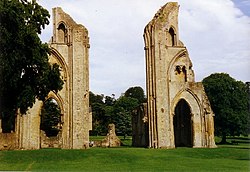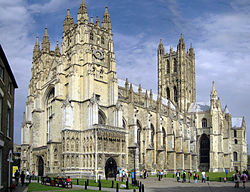
Back حل الأديرة Arabic Цюдараўская секулярызацыя Byelorussian Dissolució dels monestirs Catalan Rušení anglických klášterů Czech Diddymu'r mynachlogydd Welsh Auflösung der englischen Klöster German Dissolvo de la monaĥejoj Esperanto Disolución de los monasterios Spanish Dissolution des monastères French Díscaoileadh na Mainistreacha Irish
This article needs additional citations for verification. (June 2024) |
This article may contain an excessive amount of intricate detail that may interest only a particular audience. (June 2024) |
 |
| General |
|---|
| Early |
| Medieval |
| Early Modern |
| Eighteenth century to present |
| Part of a series on |
| Anglicanism |
|---|
 |
|
|
The dissolution of the monasteries, occasionally referred to as the suppression of the monasteries, was the set of administrative and legal processes between 1536 and 1541, by which Henry VIII disbanded all Catholic monasteries, priories, convents, and friaries in England, Wales, and Ireland; seized their wealth; disposed of their assets; destroyed buildings and relics; dispersed or destroyed libraries; and provided for their former personnel and functions.
Though the policy was originally envisioned as a way to increase the regular income of the Crown, much former monastic property was sold off to fund Henry's military campaigns in the 1540s. Henry did this under the Act of Supremacy, passed by Parliament in 1534, which made him Supreme Head of the Church in England. He had broken from Rome's papal authority the previous year. The monasteries were dissolved by two Acts of Parliament, those being the First Suppression Act in 1535 and the Second Suppression Act in 1539.
It has been described as "the greatest dislocation of people, property and daily life since the Norman Conquest."[1] Historian George W. Bernard argues that:
The dissolution of the monasteries in the late 1530s was one of the most revolutionary events in English history. There were nearly 900 religious houses in England, around 260 for monks, 300 for regular canons, 142 nunneries and 183 friaries; some 12,000 people in total, 4,000 monks, 3,000 canons, 3,000 friars and 2,000 nuns. If the adult male population was 500,000, that meant that one adult man in fifty was in religious orders.[2]
Recent historians have noted a confessional (i.e., Anglican or anti-Catholic) bias in some of the academic and popular historical material in English from previous centuries.
- ^ Scott, Brendan (29 August 2024). "Religious Communities and Their Closures in Ireland during the Sixteenth Century". Religions. 15 (9): 1055. doi:10.3390/rel15091055.
- ^ Bernard 2011, p. 390.